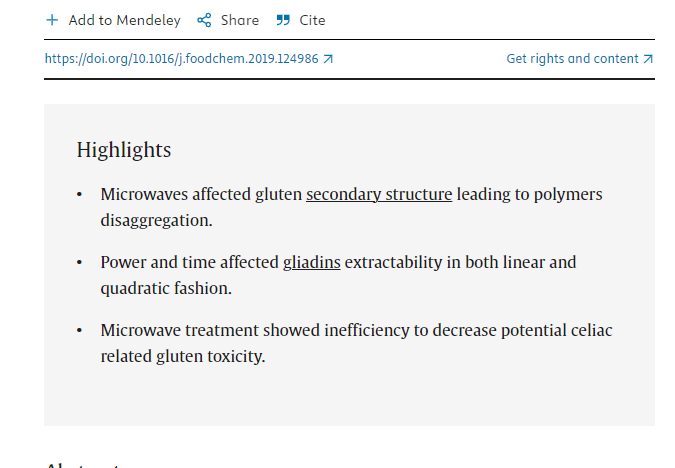How does microwave treatment of gluten affect its toxicity for celiac patients? A study on the effect of microwaves on the structure, conformation, functionality, and immunogenicity of gluten
This study aimed to investigate how microwave treatment affects the toxicity of gluten for individuals with celiac disease (CD), a condition where the immune system adversely reacts to gluten—a protein found in wheat, barley, and rye. The researchers explored the impact of microwave treatment on gluten’s structure, functionality, and its immunogenicity (ability to trigger an immune response) in CD patients. Here’s a step-by-step explanation of the important parts of the study and the implications of the results for human health:
Background and Rationale
- Celiac Disease (CD): Affects about 1% globally, with some countries having higher rates. Patients must avoid gluten to manage symptoms.
- Gluten-Free Diet Challenges: Expensive, often nutritionally inferior, and technologically limited.
- Previous Research: Focused on improving gluten-free foods or modifying gluten to reduce toxicity. Microwave treatment was proposed as a means to reduce gluten’s immunogenic properties, but findings have been mixed.
Objectives
The study aimed to gain a deeper understanding of how microwave treatment affects gluten, specifically its:
- Structure and conformation
- Functionality (how it behaves in food products)
- Immunogenicity (potential to trigger CD)
Methodology
- Experimental Design: A central composite design analyzed the effects of microwave power and treatment time on gluten properties.
- Materials: The study used vital wheat gluten powder.
- Measurements: Examined changes in gluten’s protein profile, moisture content, temperature, and structural properties. Also assessed the extractability of gliadins and glutenins, which are gluten proteins implicated in CD.
Results
- Protein and Structure Changes: Microwave treatment affected gluten’s secondary structure and disaggregated polymers.
- Gliadins and Glutenins: Power and time influenced gliadins extractability in both linear and quadratic ways, but glutenins were not affected.
- Immunogenicity: Microwave treatment did not reduce, and potentially increases, gluten toxicity for CD due to an increase in digestibility and the release of toxic epitopes after digestion.
Conclusions
Microwave treatment of gluten does not offer a safe alternative for reducing gluten toxicity for celiac patients. It may, in fact, increase the potential immunotoxicity due to changes in gluten’s structure and an increase in the release of potentially toxic epitopes.
Implications for Human Health
This study is significant for individuals with CD and those involved in the production of gluten-free foods. It indicates that microwave treatment, despite altering gluten’s structural properties, does not make gluten safe for CD patients. The findings underscore the importance of continued reliance on strict gluten-free diets for managing CD and the need for further research into safe methods for detoxifying gluten. The pursuit of alternative treatments must ensure not only the preservation of gluten’s functional qualities in food production but also the absolute safety for individuals with CD.
Microwave treatment refers to the process of exposing materials, in this context gluten-containing substances like wheat kernels, flour, or isolated gluten, to microwave radiation. Microwaves are a form of electromagnetic radiation with frequencies ranging from about 300 MHz to 300 GHz, which is used commonly in microwave ovens for heating food.
In scientific and industrial processes, microwave treatment can be used for various purposes, such as drying, heating, cooking, and chemical reactions. When applied to food or food components, microwave treatment can induce rapid heating through the interaction of the microwaves with water molecules and other polar molecules in the substance. This process can lead to changes in the physical and chemical properties of the treated material.
For gluten specifically, microwave treatment aims to alter its structure and functionality. The energy from the microwaves can affect the molecular bonds within the gluten proteins, leading to changes in its secondary structure (the way the protein chains fold and coil) and potentially affecting its functional properties in food products. Researchers have investigated microwave treatment as a potential method to modify gluten’s immunogenicity, hoping it could reduce the gluten’s ability to trigger an immune response in people with celiac disease by altering the protein’s structure in a way that makes it less recognizable to the immune system.
However, as highlighted in the study discussed earlier, while microwave treatment does change the structure of gluten, it has not been effective in reducing its toxicity for celiac disease patients and may even increase the potential immunogenicity of gluten. This indicates that while microwave treatment can modify gluten, the changes may not be beneficial for making gluten safe for individuals with celiac disease.








